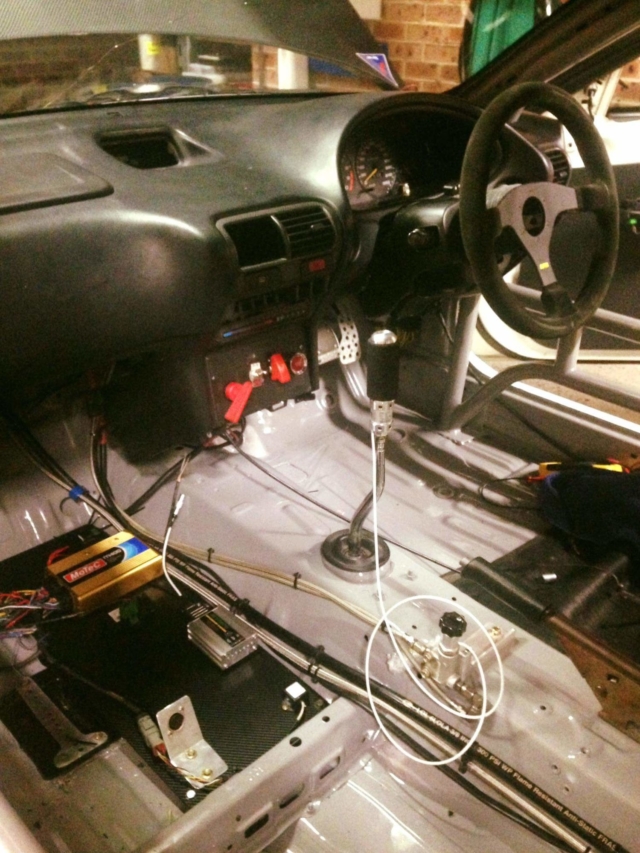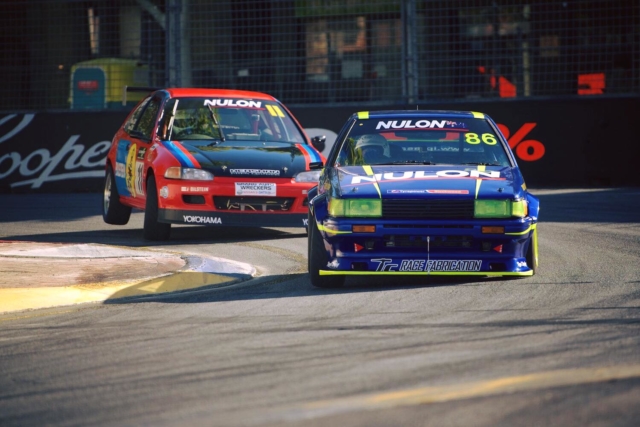Jordan Cox’s underpowered Civic has made itself into a cult icon thanks to some of the success its had in production car racing down under. The lightweight lima bean might only have 260 horsepower courtesy of a Type-R’s B20, but its nimbleness and well-sorted JRZ suspension allow it to use every pony while bouncing off the curbs at Adelaide.
Thanks to its curb weight, it also has no difficulty running down V8-powered cars at a fast track like Mt. Panorama. However, the tight confines of Adelaide call for a different slew of abilities. One of them is an incisive front end and some natural balance to deal with the relatively slippery surface; Adelaide is a public road most of the year, and doesn’t have the sticky race rubber impregnated into the asphalt like a full-time track does.
Under those conditions, perhaps there’s no better production car than the job than the Toyota AE86. Wearing a Levin front bumper, Chris Brown’s AE86 has the balletic nimbleness needed to regularly rotate on a slippery street course. Not only does the incisive chassis help rotation, but the power on demand can turn a mild yaw into a full pirouette. Therefore, a relaxed application of the throttle is needed to keep three-hundred horsepower from roasting the rears.
That thrust comes from a Toyota 3SGTE—the engine most commonly found in the MR2 Turbo—with a good deal of modification. The stock 3SGTE, force-fed by a Garrett 2871 turbo, provided enough grunt for street use until Brown decided to pop in a cage, pull the carpets, and make it a dedicated track toy.
Then went in a Holinger sequential gearbox, a bigger Borg-Warner turbocharger, and Wilwood custom brakes underneath 15″ wheels wrapped in 225/50/15 Yokohama A050 tires. Best of all, Suspension Concepts designed a custom setup to harness the turbocharged thrust and make the tail-happy drift machine a decent road course carver. As impressive as the Toyota’s handling is, it’s not quite as well optimized for the specific demands of this street course as the Civic.
Just observe the way Cox’s Civic sits high and leans quite heavily for a racing car. This soft setup makes it compliant, and gives him the ability to hop curbs and improve his corner- exit acceleration, whereas Brown’s AE86 needs to tread more carefully over those slippery, painted curbs. This helps compensate somewhat for the obvious power discrepancy, as does the Civic’s rotating tail, which helps him rotate the car into the corner consistently.

As seen here, a brake bias adjuster helps Cox change the Civic’s personality on the fly. Photo credit: honda-tech.com
A loose setup is a fast setup—especially on a slow circuit like Adelaide. With a twist of the inboard brake bias adjuster, Cox can dial more towards the rear for a little oversteer on turn-in. However, he can twist the knob in other direction to maximize the car’s deceleration in the demanding braking zones. This latter ability helps him defend against Brown and his obvious straightline advantage.

Photo credit: Jordan Cox Motorsport
Though Cox has to relinquish the lead after that first dramatic pass, his confidence (and better tires) allow him to try something similar on the final lap. However, Brown’s car positioning is effective if not just on the limit of good taste. A frightening squeeze and a brief rub, and Cox is kept at bay. Though that sort of defensiveness is bordering on dangerous, it’s understandable on the last lap. Fortunately, these two know how to give just enough space between one another to ensure nail-biting action without much damage.
That doesn’t stop him from putting making a punchy, do-or-die display over the last lap. Putting his nose inside and using every advantageous piece of asphalt underneath him, Cox puts in a sterling effort which, though it didn’t give him the win, ought to give him a decent contract in the near future.
https://






















